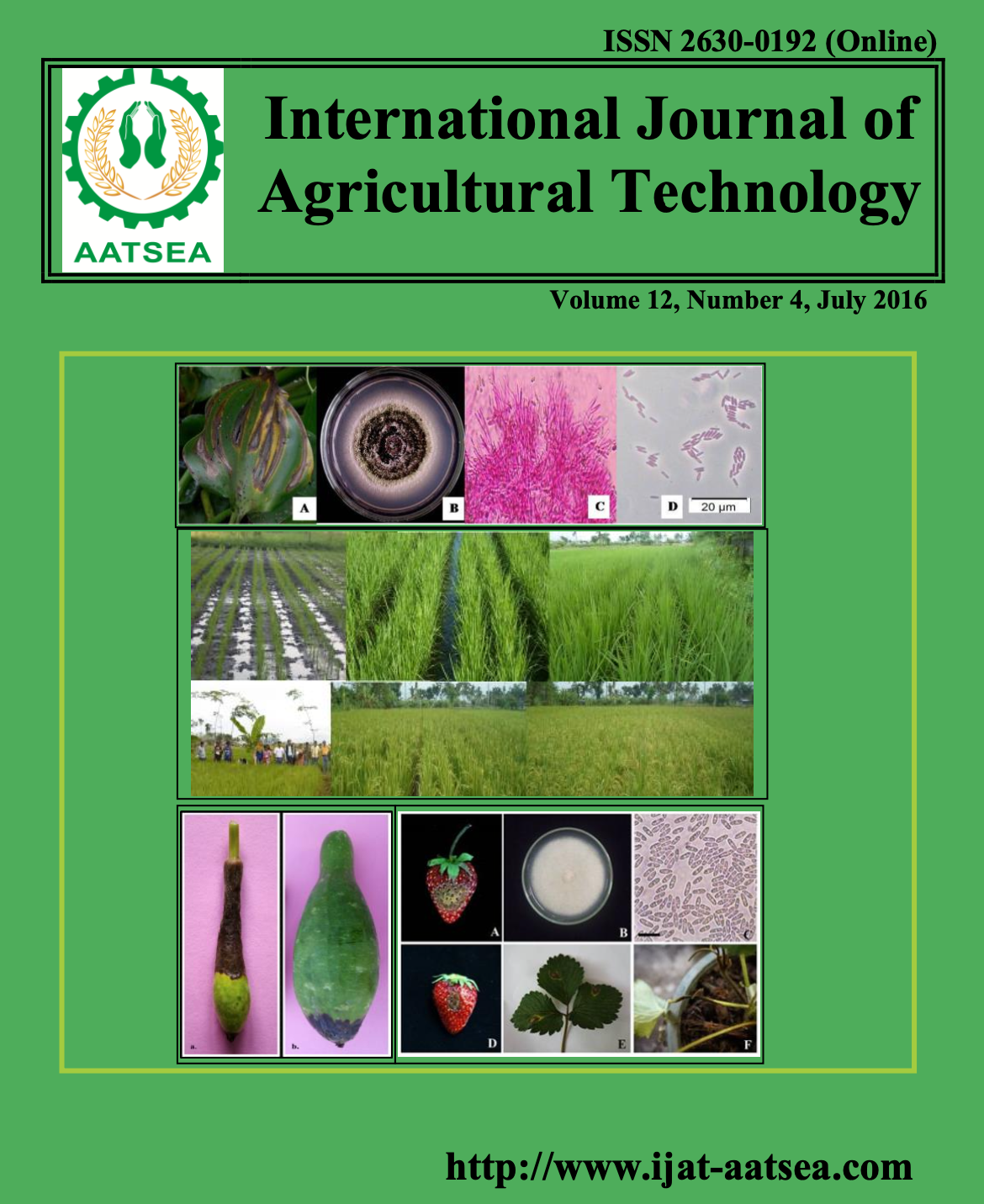Effect of weather parameters on blue pine (Pinus wallichi ana J.) needle blight and ascospore release of Lophodermium pinastri in India
Main Article Content
Abstract
During the study period maximum logrithemic infection rate of 0.0618 and 0.0285 unit/day was recorded during the first fortnight of April in 2008 and 2009, respectively. Weather factors viz. temperature and relative humidity were positively correlated with disease intensity (62.1 per cent contribution). However, except temperature all other weather factors were positively correlated with the disease development in terms of infection rate (units/day) (25.7 per cent contribution).The correlation studies of various meteorological factors with disease development revealed significant positive correlation of disease intensity with mean temperature, wind speed and relative humidity. The correlation of disease intensity with rainfall and wind speed was negative. The apparent infection rate was negatively correlated with temperature, but positively correlated with relative humidity, rainfall and wind speed. The multiple linear regression fitted to data revealed that weather factors influenced the disease intensity to the extent of 62.1 per cent in 2008-2009 and for infection rate to the extent of 25.7 per cent. Correlation of various meteorological factors with spore release revealed that spore release and temperature were negatively correlated during whole season (2009) but positively correlated for August-September period. The correlation of spore release with relative humidity, rainfall and wind speed was significantly positive during whole season. The disease incidence depicted negative correlation with temperature, rainfall and wind speed but was positively correlated with RH. Multiple regression analysis of spores released per cm2 and disease incidence with weather parameters revealed the coefficient of determination (R2) of 43.9, 72.6 and 21.0 per cent for the spores released was during June-July, August-September periods and in whole season, respectively. However, it was 35.0, 90.9 and 90.3 per cent for disease incidence during June-July, August-September and in whole season on Blue pine plantations.
Article Details

This work is licensed under a Creative Commons Attribution-NonCommercial-NoDerivatives 4.0 International License.
References
Ahangar, F. A., Dar, G. H., Beig, M. A. and Sofi, T. A. (2011). First report of needle blight on Blue pine (Pinus wallichiana) and Aleppo pine (P. halepensis), caused by Lophodermium macci, from Asia. Plant Pathology Journal 10:181-186.
Aminev, P. I. (1980). Bioecological long-term seasonal forecast of ordinary needle cast of pine in the Lenigrad region. Mikologiya i Fitopatologiya 14:223-228.
Chwalinski, K. (1978). Mycoflora of needle tissues of common pine developing within the limits of infectious spots attributed to Lophodermium pinastri (Schard.) Chevall. Zeszyty Problemowe Postepow Nauk Rolniczych 213:231-236.
Douce, G. K, Moorhead, D. J. and Bargeron, C. T. (2002). Forest Pest Control, Special Bulletin 16, College of Agricultural and Environmental Sciences, The University of Georgia, USA.
Fedorov, N. I. and Yakimov, N. I. (1979). Dispersal and germination of the spores of Lophodermium pinastri in Belorussia. Biologicheskie Nauki 2:45-47.
Gomez, K. A. and Gomez, A. A. (1984). Statistical Procedure for Agricultural Research. 2nd edition. John Wiley and Sons, Inc., New York.
Hanso. M. and Hanso, S. (2001). An epidemic of Lophodermium needle cast. Eesti Mets (Estonian Forest) 4-6:22-23.
Hanso, M. and Drenkhan, R. (2008). First observations of Mycosphaerella pini in Estonia. Plant Pathology 57:11-77.
Hanso, M. (1970). Die ganzjährige Kiefernnadelschütte in phytopathologischer Sicht. Forestry Studies 8:260-274.
Johansen, R. W. and Wade, D. D. (1987). Effects of crown scorch on survival and diameter growth of slash pines. Southern Journal of Applied Forestry 2:180-184.
Kirk, P. M., Cannon, P. F., Minter, D. W. and Stalpers, J. A. (2008). Ainsworth and Bisby’s Dictionary of the Fungi, 10th edn. CAB International, Wallingford, UK. pp. 1-771.
Kowalski, T. (1982). Fungi infecting Pinus sylvestris needles at various ages. European Journal of Forest Pathology 12:182-190.
Kulkarni, S. A. (2009). Epidemiology and integrated management of anthracnose of greengram. Ph.D. Thesis submitted to Dharward University of Agriculture Sciences, Dharward. India, pp. 170.
Linzon, S. N. (1968). Etiological studies on needle fungi associated with semi-mature tissue needle blight of eastern white pine. Canadian Journal of Botany 46:1565-1574.
Millar, C. S. and Minter, D. W. (1980). Naemacyclus minor. CMI Descriptions of Pathogenic Fungi and Bacteria No. 659. CMI, Kew, Surrey, England.
Millar, C. S. and Watson, A. R. (1971). Two biotypes of Lophodermium pinastri in Scotland. Europian Journal of Forest Pathology 1:87-93.
Minter, D. W. (1981). Lophodermium on pines. Mycological Papers 147:1-54.
Minter, D. W. and Sharma, M. P. (1982). Three species of Lophodermium from the Himalayas. Mycologia 74:702-711.
Nicholls, T. H. and Skilling, D. D. (1974). Control of Lophodermium needlecast disease in nurseries and Christmas tree plantations. USDA Forest Service Research Paper. NC-110, pp. 11.
Ortiz-García. S., Gernandt, D.S., Stone, J.K., Johnston, P.R., Chapela, I.H., Salas, L.R and Alvarez, B. ( 2003). Phylogenetics of Lophodermium from pine. Mycologia 95:846-859.
Ostry, M. E. and Nicholls, T. H. (1992). A technique for trapping fungal spores. USDA North central Forest Experimental Station, St Paul, Minnesota Research note. NC-283, pp. 1-4.
Pagony, H. and Gasko, E. (1977). Controlling effect of Scotch pine by Lophodermium pinastri in nurseries. Erdo 26:425-429.
Pagony, H. (1971). The course of the weather and control of the Lophodermium needlecast. Przebieg Pogody a Zwalczanie Osutki Sosny 127:109-116.
Raspopov, P. M. (1980). Dates of ascospore discharge of the pathogen of needlecast in the south Ural and optimal times for prophylactic sprayings. Mikologiya i Fitopatologiya 14:440-445.
Scharpf, R. F. (1986). Effect of a foliage disease caused by Lirula abietisconcoloris on growth of white fir in California. Plant Disease 70:13-14.
Skilling, D. D. and Nicholls, T. H. (1974). Brown spot needle diseases: Biology and control in Scotch pine plantations. USDA Forest Service Research Paper NC-109.
Staley, J. M. (1975). The taxonomy of Lophodermia on pines with special reference to problems in North American Christmas tree plantations. Mitt. Bundesforschungsanst. Forst-Holzwirtsch., Reinbek 108:79-85.
Vanderplank, J. E. (1963). Plant Disease: Epidemics and Control. Academic Press, New York, USA, p. 349.
Woods, A. J. (2003). Species diversity and forest health in Northwest British Columbia. The Forestry Chronicle 79:892-897.


